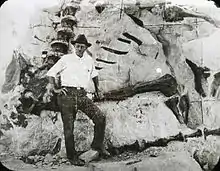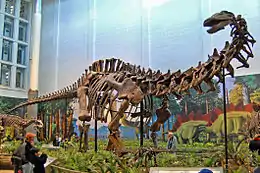Earl Douglass
Earl Douglass (October 28, 1862 – January 13, 1931) was an American paleontologist who discovered the dinosaur Apatosaurus, playing a central role in one of the most important fossil finds in North America.[1][2][3] By 1922 Earl had unearthed and shipped more than 700,000 pounds of material including nearly 20 complete skeletons of Jurassic dinosaurs such as Diplodocus, Dryosaurus, Stegosaurus, Barosaurus, Camarasaurus and Brontosaurus.[4][5][6][7]

Personal life
Douglass was born on October 28, 1862 in Medford, Minnesota, the son of Fernando and Abigail Louisa Carpenter Douglass.[1][3][8] He married Pearl Charlotte Goetschius on October 20, 1905 and a few years later they had a son, Gawin Earl Douglass.[8] Douglass died on January 13, 1931 in Salt Lake City, Utah.[8]
Education
Douglass's early education was in the Medford public schools and the Pillsbury Academy in Owatonna, Minnesota, where he studied geology, paleontology, osteology, and mammalian anatomy.[8][9] Later at the Shaw School of Botany at Washington University, he studied systematic botany and plant histology.[8] Douglass received his master's of Science at the University of Montana in 1899.[9] The following year at Princeton University he held a fellowship in biology, and he was granted a fellowship in geology.[9][8]
Career
In 1899, Douglass taught geology and physical geography at the University of Montana.[9] In 1902, Douglass was hired at the Carnegie Museum of Natural History to work in the field of paleontology and worked there for 15 years.[8][1][5] From 1923 to 1924, he worked with the National Museum and University of Utah to obtain dinosaur fossils and discovered a large part of a skeleton known as Barosaurus lentus.[3][1] The following year, he was employed by the University of Utah to excavate dinosaur bones.[9]
After a botanical trip to Mexico in 1890, Douglass became assistant to Professor William Trelease at the Missouri Botanical Garden.[9] Because he did notable research on oil, oil shale, asphalts, and other mineral deposits, he became consulting geologist for companies engaged in these fields in Utah, Colorado, Arizona and Texas.[9] His final years were spent as a geologist.[3]
Work and contributions

Douglass played a central role in one of the most important fossil finds in North America.[3] In 1905, he was sent to Minnesota, North Dakota, Montana, and Idaho to collect vertebrate and invertebrate fossils. Additionally, he obtained data to solve certain geological problems and conduct geological explorations.[8][9] In 1907, Douglass traveled to the Uintah Basin in northeastern Utah to explore fossiliferous strata.[8] Later in 1908, he explored the hills along the Green River near Jensen, Utah and came upon with the tail section of an Apatasaurus in the Morrison Formation.[5] The following year while searching fossils for the Carnegie Museum, he discovered a formation layered with prehistoric plant and animal fossils.[10] In the summer of 1909, Earl traveled to Utah to search for dinosaur skeletons, where he discovered his famous dinosaur at the Utah quarry.[3] The dinosaur was formally named Apatosaurus louisae, after Carnegie’s wife Louise.[9][2][1] In the same year, while climbing the Split Mountain near Jenson, Utah he found eight large vertebrae partially embedded in the rock, which turned out to be the entire body of a brontosaur nearly 70 feet long.[11]
References
- Linda Hall Library (October 27, 2016). "Earl Douglass - Scientist of the Day". Retrieved April 18, 2017.
- Switek, B (June 28, 2011). "A Visit to Douglass' Dinosaur". Retrieved April 18, 2017.
- "Earl Douglass". Retrieved April 18, 2017.
- K.W. (2015). Tumbleweeds and Shiny Braids Rv Travel Journal Out West. Authorhouse. ISBN 978-1504914864.
- Strand, H (May 23, 2016). "Earl Douglass and Dinosaur National Monument". Retrieved April 18, 2017.
- Preston, D. J. (1994). Dinosaurs in the attic: an excursion into the American Museum of Natural History. New York: St. Martin's Press. ISBN 1466871873.
- Lucas, S. G. (2006). America's antiquities: 100 years of managing fossils on federal lands. NM: New Mexico Museum of Natural History & Science.
- "Douglass, Earl, 1862-1931". Retrieved April 18, 2017.
- Strand, H (May 23, 2016). "Earl Douglass, Geologist, Paleontologist". Retrieved April 18, 2017.
- "Dinosaur National Monument". Retrieved April 18, 2017.
- Ison, Y. D. (March 1995). ""Dinosaur Rush" Created Excitement in Uinta Basin". Retrieved April 18, 2017.